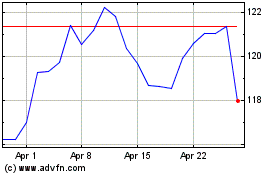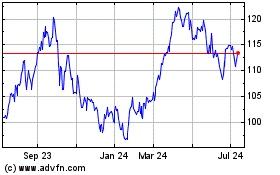By Sarah Kent and Lynn Cook
The world's biggest energy companies are treating with caution
the rally that briefly lifted crude-oil prices over $50 a barrel
this week, wary of boosting spending and production too soon.
Companies including Exxon Mobil Corp., Royal Dutch Shell PLC and
BP PLC spent huge sums on giant new oil and natural-gas projects as
prices surged over the past decade, only to make large
corresponding cuts to their development budgets when prices plunged
in 2014 and 2015.
Oil prices are recovering, topping $50 a barrel for the main
global benchmark on Thursday -- nearly double the price in January
-- before retreating to $49.33 a barrel on Friday. But companies
are moving more slowly to start new drilling and production this
time around.
"We're not going to try and get into a boom and bust," BP's
chief financial officer, Brian Gilvary, said in a conference call
last month. Even at $60 a barrel, he said, "We wouldn't be looking
to significantly ramp [activity] up."
Shell this week announced a fresh round of job cuts across its
business, bringing its total planned for the year to at least
5,000. Earlier this month, the Anglo-Dutch company said it would
cut its planned 2016 spending on new projects by nearly 10%.
Oil hitting $50 a barrel may boost smaller producers in places
like the U.S.'s shale fields, sending their relatively low-cost
projects into the black. But many of the expensive, long-term
projects that big oil companies specialize in, such as deep-water
wells, require higher prices to be profitable.
Still, some larger oil companies say they can boost production
as prices reach the $50 threshold, though the increase may be
modest.
Although many of Chevron Corp.'s mega projects around the globe
need higher prices to be profitable, the company recently said its
Permian Basin operations in West Texas can hum along with crude at
$50. Chevron has slashed 40% from its costs in the area and now has
4,000 wells there that give a 10% rate of return when West Texas
Intermediate, the U.S. benchmark price, is at $50.
"We are now in full horizontal factory mode in the Permian,"
said Joe Geagea, an executive vice president for technology and
services at Chevron, comparing drilling operations there to a
streamlined manufacturing process.
Exxon hit the brakes this year, slashing its budget by 25% and
dropping the number of drilling rigs it runs in the U.S. from close
to 60 at the height of the oil boom to about 16 as it delayed shale
production. What will it take for Exxon to step on the gas
again?
"It's not really a price trigger for us," said Jeff Woodbury,
vice president of investor relations, when Exxon discussed
first-quarter earnings in late April. The company cares more about
the broad supply-and-demand balance across the whole world, he
said.
Global oil demand is growing, but not fast enough to outpace the
crude supply glut that has built up over the two years. A forecast
from the International Energy Agency now projects a strong rebound
in the second half of 2016, with oil demand rising by 1.8 million
barrels a day to 96.8 million barrels a day by the fourth
quarter.
Although many U.S. producers have said $50 oil won't spur them
to rush out and tap new wells, one of the bigger uncertainties is
whether the $50 threshold will lead them to finish the many wells
that are drilled but not yet pumping in fields from Texas to North
Dakota -- estimated at nearly 4,000 according to data from
consulting firm Rystad Energy.
"Consensus appears to be building around the notion that $50 to
$55 is tantamount to an industry 'all clear,'" analysts at Tudor,
Pickering, Holt & Co. said.
Further out in the futures market, oil is trading over $50 a
barrel into 2017. That allows companies to hedge their future
output by locking in higher prices today for oil they won't pump
until next year, said John England, a vice chairman of oil for
Deloitte LLP in Houston.
"A kind of cautious optimism is starting to creep back into the
market, even though some support for higher crude prices stems from
temporary outages like wildfires in Canada that have shut down
oil-sands production and attacks on pipelines in Nigeria," Mr.
England said.
:The prevailing view on Wall Street is that $60-a-barrel oil is
the new $90, the price needed to trigger the sort of production
growth seen during the last upswing that peaked in 2014, said Evan
Calio, head of U.S. oil research at Morgan Stanley.
He says that conventional wisdom may be wrong. While some shale
producers may start pumping from wells drilled but not completed if
oil hangs above $50 a barrel, most will need months of stable
prices before they can borrow enough money to ramp up output again,
he said.
"Growth will take longer to return than the market expects,"
said Mr. Calio, who thinks it will take $80 oil prices for American
production to increase again.
While large companies are behaving cautiously, some smaller
producers are showing resiliency in the face of low prices.
Mike Dynan, vice president of strategy for drilling-equipment
maker Schramm Inc., said more small producers are deploying
smaller, faster rigs that can punch holes in the ground in less
than 48 hours.
"They can't control the price of oil, but they can push their
costs down, " he said. "That's what's scary to the rest of the
world. The Americans are going to find a way to make some
money."
--Erin Ailworth contributed to this article.
Write to Sarah Kent at sarah.kent@wsj.com and Lynn Cook at
lynn.cook@wsj.com
(END) Dow Jones Newswires
May 27, 2016 16:37 ET (20:37 GMT)
Copyright (c) 2016 Dow Jones & Company, Inc.
Exxon Mobil (NYSE:XOM)
Historical Stock Chart
From Mar 2024 to Apr 2024

Exxon Mobil (NYSE:XOM)
Historical Stock Chart
From Apr 2023 to Apr 2024
